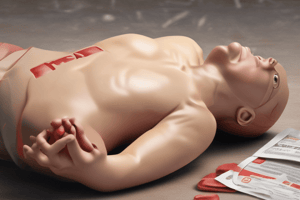Podcast
Questions and Answers
What do the stars in the answer represent?
What do the stars in the answer represent?
[answer] ✰✰✰✰✰✰
What should you check for before you respond to an emergency situation?
What should you check for before you respond to an emergency situation?
Your safety
What is Hands-Only CPR?
What is Hands-Only CPR?
- When you use whatever hand you want
- When you provide CPR compressions without breaths
- A method of CPR you can use if you do not remember conventional CPR steps
- Both B and C (correct)
What is the recommended rate for performing chest compressions for victims of all ages?
What is the recommended rate for performing chest compressions for victims of all ages?
Check for a victim's responsiveness by ____________.
Check for a victim's responsiveness by ____________.
What is the correct hand placement when performing chest compressions on an adult?
What is the correct hand placement when performing chest compressions on an adult?
When performing CPR on an adult, you should push the chest at least _____ inches deep.
When performing CPR on an adult, you should push the chest at least _____ inches deep.
What should you do after about 5 cycles of compressions when you are tired?
What should you do after about 5 cycles of compressions when you are tired?
What steps should you follow to open the airway?
What steps should you follow to open the airway?
The most common airway obstruction in an adult is _______.
The most common airway obstruction in an adult is _______.
How long should each of the two breaths be for an adult?
How long should each of the two breaths be for an adult?
During infant CPR, you should push down ______ inches deep at a rate of at least ______ compressions per minute.
During infant CPR, you should push down ______ inches deep at a rate of at least ______ compressions per minute.
When giving chest compressions to an infant you should use _____
When giving chest compressions to an infant you should use _____
When caring for an unresponsive infant or child, what should you do before calling 9-1-1?
When caring for an unresponsive infant or child, what should you do before calling 9-1-1?
Before pushing the 'shock' button on an AED, you should _______.
Before pushing the 'shock' button on an AED, you should _______.
What is the universal choking sign?
What is the universal choking sign?
When helping a choking child, you should give ________.
When helping a choking child, you should give ________.
Flashcards
Meaning of stars in answer?
Meaning of stars in answer?
The stars in the answer likely represent missing content.
First action in an emergency?
First action in an emergency?
Before responding, always check for your own safety to prevent becoming a victim yourself.
What is Hands-Only CPR?
What is Hands-Only CPR?
CPR using only chest compressions without rescue breaths.
CPR compression rate?
CPR compression rate?
Signup and view all the flashcards
Checking responsiveness?
Checking responsiveness?
Signup and view all the flashcards
Hand placement for adult CPR?
Hand placement for adult CPR?
Signup and view all the flashcards
CPR compression depth (adult)?
CPR compression depth (adult)?
Signup and view all the flashcards
CPR exhaustion?
CPR exhaustion?
Signup and view all the flashcards
Opening the airway?
Opening the airway?
Signup and view all the flashcards
Common airway obstruction?
Common airway obstruction?
Signup and view all the flashcards
CPR breath duration?
CPR breath duration?
Signup and view all the flashcards
Infant CPR depth/rate?
Infant CPR depth/rate?
Signup and view all the flashcards
Infant CPR hand placement?
Infant CPR hand placement?
Signup and view all the flashcards
CPR before calling 911?
CPR before calling 911?
Signup and view all the flashcards
AED shock preparation?
AED shock preparation?
Signup and view all the flashcards
Choking Sign?
Choking Sign?
Signup and view all the flashcards
Helping a choking child?
Helping a choking child?
Signup and view all the flashcards
Study Notes
CPR/AED Training Key Points
- Always check for personal safety before responding to any emergency situation.
- Hands-Only CPR involves providing chest compressions without breaths; it is suitable if the responder does not remember conventional CPR steps.
- Perform chest compressions at a rate of 100 to 120 compressions per minute for victims of all ages.
- To check a victim's responsiveness, tap them and shout, "Are you okay?"
- Correct hand placement for adult chest compressions: one hand on top of the other, fingers interlaced.
- When performing CPR on an adult, compress the chest at least 2 inches deep, but no more than 2.4 inches.
- After about five cycles of CPR compressions, switch with your partner to avoid fatigue.
- To open the airway, tilt the head back and lift the chin.
- The tongue is the most common airway obstruction in adults.
- Each breath given to an adult should last 1 second.
- In infant CPR, compress the chest 1.5 inches deep, at a rate of 100 to 120 compressions per minute.
- When giving chest compressions to an infant, use 2 fingers for proper technique.
- For an unresponsive infant or child, provide care first, including about 5 cycles of CPR, before calling 9-1-1.
- Before pushing the "shock" button on an AED, ensure no one is touching the victim, the AED is on, and that the area is dry.
- The universal sign for choking is when an individual holds their neck with one or both hands.
- To assist a choking child, deliver abdominal thrusts to help dislodge the obstruction.
Studying That Suits You
Use AI to generate personalized quizzes and flashcards to suit your learning preferences.




